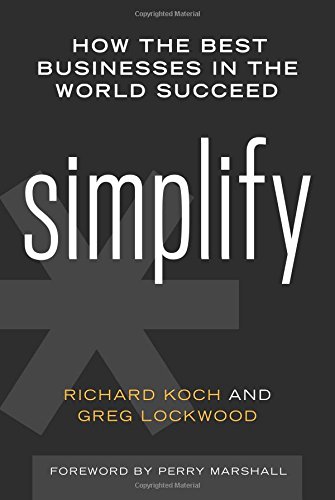This book talks about great simplifiers in the business world. It says that there are only 2, almost opposite, ways of Simplifying: Price-simplifying & Proposition-simplifying. It also explains how to do both these simplifications!
Part 1: Great Simplifiers
- Henry Ford: Simplified the Ford Model T so that it was not only easy to build and maintain by also could be driven by anybody. By reducing the price the market size dramatically increased
- IKEA: They achieved price levels that blocked competitors with big stores outside town and direct delivery from the manufacturer to store.
- McDonalds: Simple menu with good food at a price half of what you would expect anywhere else. The menu is fixed in price and the choice has been decided by the restaurant. But in addition McDonalds makes a point of usability, e.g. no tipping.
- The Consultants: The BCG’s 4 box system, cash cows, question marks, dogs and stars. It was a simple package that enabled young rookies to “advise” companies what their strategy should be
- Uber: Used technology to link customers with providers and take a 20% cut of the fee! Welcome to the 21st century of a networked world. Uber scores well on ease of use and utilityand the ‘Art’ as the author calls it, he means the overall experience
There are two almost opposite ways to simplify:
- Price-simplifying – the route taken by Henry Ford, by McDonald’s, Southwest Airlines, IKEA, Charles Schwab, and Honda – This requires cutting the price of a product or service in half, or more – sometimes over a number of years the price can be cut to a tenth of its previous level. If the price of a product is halved, demand doesn’t double. It soars. And if the product or service is simple enough, it can be sold everywhere around the world – There is a common template adopted by all price-simplifiers
- Proposition-simplifying – involves making a product or service a Joy to use by making it simpler: more useful, easier to use, and more elegant. Companies who have done this brilliantly include Google, Uber, Apple, ARM, Tetra Pak, and The Boston Consulting Group
Whereas price-simplifying is all about making it simpler for the Producer, proposition-simplifying is all about making it simpler for the Customer
Part 2: How to Simplify
Proposition Simplify: This happens in 3 steps:
Step 1: Make the product/service easier to use
- Eliminate features: Keep only what is absolutely required
- Make your product intuitive and easier. Hide Complexity. Is it Joy to Use?
- Make it Faster: Nespresso, faster coffee anyone?
- Make it smaller/lighter/portable.The Sony Walkman
- Finally, make the product/service easier to obtain. iTunes, Uber
Step 2: Make it more useful
- Vary the performance (make it more or less powerful)
- Improve quality
- Add new features, but only if it does not undermine Step 1
- Provide a wider range of services
- Personalize it
Step 3: Make it more aesthetically appealing
Product design is a crucial aspect of any consumer product, web design etc. e.g. MySpace’s demise. It had a cluttered and messy interface when Facebook offered a nice clean one
How to Price Simplify
Radically reduce the costs not just within the product but also the company to allow a profitable price reduction. To be meaningful the price has to be reduced by 50% or more.
9 step method to achieving price simplification:
Step1: Subtract features: No food in planes
Step2: Reduce variety: Ford
Step3: Add cheap benefits: IKEA Children play areas
Step 4: Automate: be able to scale your product selling
Step 5 Orchestrate
Step 6: Co-opt customers: McDonalds
Step 7: Sell direct
Step 8: Use simpler technology
Step 9: Scale Up: Grow quickly. Make it difficult for anyone else to copy your business

